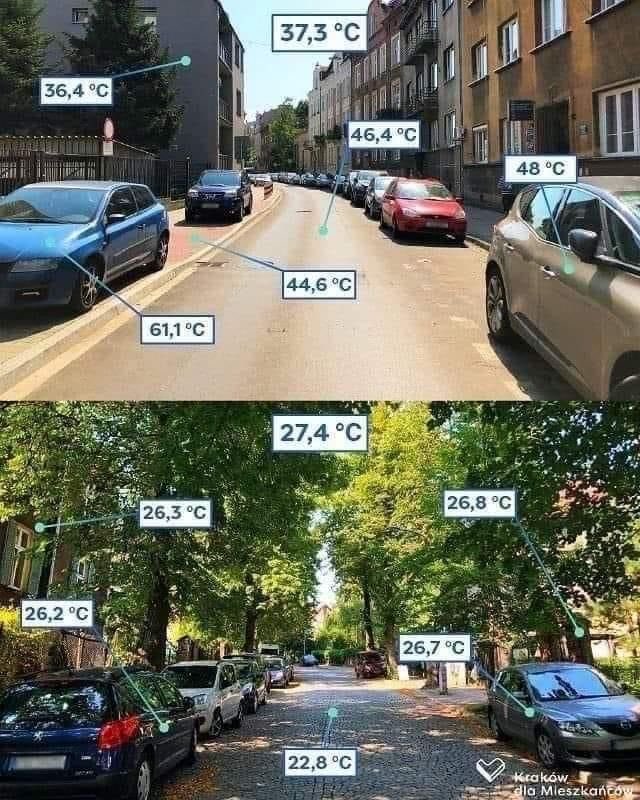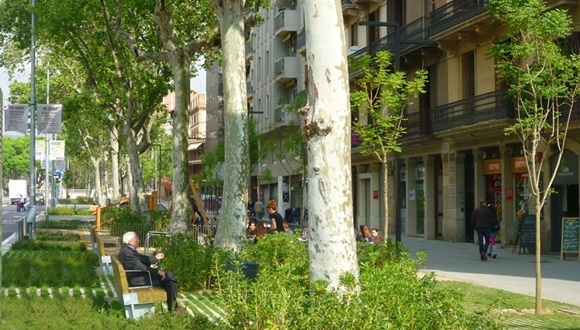Trees are a must for the cities of the future
A few days ago, the Copernicus Earth observation programme published a hair-raising satellite image. It shows the land surface temperature in some parts of Spain exceeding 53°C, despite summer having only just begun. Heatwaves of the kind reflected in the image are particularly apparent in towns and cities, where most of the population live, but they could be more bearable if there were more trees. Tree-lined streets obviously provide more shade to take cover in when the mercury rises, but trees offer many other benefits too.
As a consequence of urbanization, towns and cities have a much warmer climate than their surroundings. This is called the “heat island” effect, and its extent depends, among other factors, on how many buildings there are and how tall they are, and on the presence or otherwise of factories, open spaces and water points. One of the main causes of the effect is that concrete retains much more heat than the same volume of air does, so the “greyer” a town or city is, the more likely its inhabitants are to experience excessive heat.
Shade, moisture and coolness
Even if they do not provide shade, plants help to cool the atmosphere by releasing water into it through transpiration.
Nonetheless, we have an ally in our battle against heat islands: plants. Even if they do not provide shade, plants help to cool the atmosphere by releasing water into it through transpiration. Given that transpiration is a physiological process that varies according to a tree’s physiognomy, crown type, leaf surface area, etc., careful planning of urban greenery is vital in order to choose the most beneficial species of trees and bushes.
According to a study published recently in Nature Reviews, vegetation on the ground reduces peak surface temperatures by 2-9°C, while green roofs and walls reduce surface temperatures by approximately 17°C!

Energy savings and health benefits
And the list goes on! Another benefit of trees is that they help us make savings in our homes. Research has shown that trees in streets keep the temperature of nearby buildings down, meaning that the people who live in them do not need to use air conditioning as frequently. That not only entails lower household electricity bills but also contributes to citywide energy savings.
Widespread tree planting in cities could offset increases in heat-attributable deaths as climate change progresses.
Additionally, decent urban forests provide refuge from the sun’s heat, reducing the risk of people suffering from heatstroke and other associated health problems. That particular aspect of the fight against global warming was highlighted in a recent Harvard University study, which found that widespread tree planting in cities could offset increases in heat-attributable deaths as climate change progresses.
Climate shelters
Science has actually coined a term for such areas that provide respite from the heat. They have become known as climate shelters, defined as places that offer environmental conditions favourable to the mitigation of the effects of climate change (not only for humans but also animals and plants).Other types of climate shelters, besides wooded areas, include fountains with drinking water (for people), reservoirs and lakes (for animals), and areas with mainly natural surface cover.
Not all trees have the same capacity to protect us from the sun, of course. Deciduous trees are ideal, as they offer shade in summer and let sunshine through in winter. And if they have broad leaves that cast more shadow, better yet. Furthermore, as climate shelters also provide homes for flora and fauna, they can boost urban biodiversity.

Adaptation in times of climate crisis
Lastly, it is worth noting that urban wooded areas help us mitigate other effects of climate change besides heat. Having trees in towns and cities purifies the air, aids the retention of suspended particles emitted by traffic, helps to increase atmospheric carbon sequestration, contributes to reduced soil erosion (due to support from tree roots), and diminishes the effects of flooding, among many other ecosystem services.
Solutions of the kind mentioned here will be increasingly necessary to combat the relentless global warming we are facing. Bearing in mind all the benefits trees offer us in towns and cities — more shade, more moisture, energy savings, a lower risk of heatstroke, and help with adaptation to climate change — can there be any doubt as to the direction urban development should be taking?







